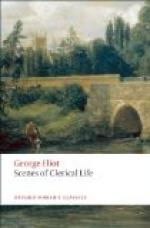At the other end of the table, as ‘Vice’, sits Mr. Fellowes, rector and magistrate, a man of imposing appearance, with a mellifluous voice and the readiest of tongues. Mr. Fellowes once obtained a living by the persuasive charms of his conversation, and the fluency with which he interpreted the opinions of an obese and stammering baronet, so as to give that elderly gentleman a very pleasing perception of his own wisdom. Mr. Fellowes is a very successful man, and has the highest character everywhere except in his own parish, where, doubtless because his parishioners happen to be quarrelsome people, he is always at fierce feud with a farmer or two, a colliery proprietor, a grocer who was once churchwarden, and a tailor who formerly officiated as clerk.
At Mr. Ely’s right hand you see a very small man with a sallow and somewhat puffy face, whose hair is brushed straight up, evidently with the intention of giving him a height somewhat less disproportionate to his sense of his own importance than the measure of five feet three accorded him by an oversight of nature. This is Rev. Archibald Duke, a very dyspeptic and evangelical man, who takes the gloomiest view of mankind and their prospects, and thinks the immense sale of the ’Pickwick Papers,’ recently completed, one of the strongest proofs of original sin. Unfortunately, though Mr. Duke was not burdened with a family, his yearly expenditure was apt considerably to exceed his income; and the unpleasant circumstances resulting from this, together with heavy meat-breakfasts, may probably have contributed to his desponding views of the world generally.
Next to him is seated Mr. Furness, a tall young man, with blond hair and whiskers, who was plucked at Cambridge entirely owing to his genius; at least I know that he soon afterwards published a volume of poems, which were considered remarkably beautiful by many young ladies of his acquaintance. Mr. Furness preached his own sermons, as any one of tolerable critical acumen might have certified by comparing them with his poems: in both, there was an exuberance of metaphor and simile entirely original, and not in the least borrowed from any resemblance in the things compared.
On Mr. Furness’s left you see Mr. Pugh, another young curate, of much less marked characteristics. He had not published any poems; he had not even been plucked; he had neat black whiskers and a pale complexion; read prayers and a sermon twice every Sunday, and might be seen any day sallying forth on his parochial duties in a white tie, a well-brushed hat, a perfect suit of black, and well-polished boots—an equipment which he probably supposed hieroglyphically to represent the spirit of Christianity to the parishioners of Whittlecombe.




